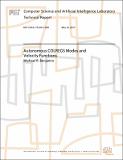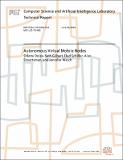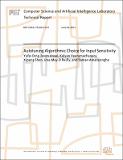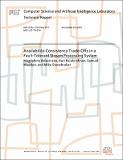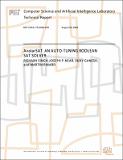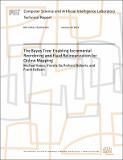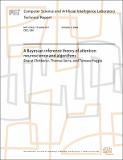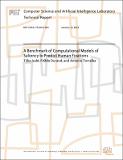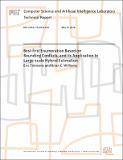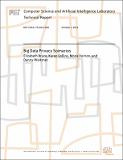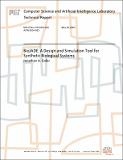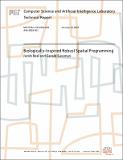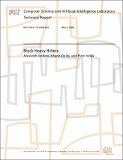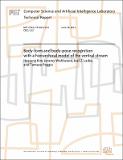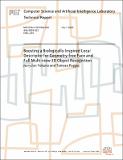Browsing CSAIL Technical Reports (July 1, 2003 - present) by Title
Now showing items 93-112 of 775
-
Autonomous COLREGS Modes and Velocity Functions
(2017-05-16)This paper concerns an implementation of an autonomy system for unmanned surface vessels operating in accordance with the Coast Guard Collision Regulations (COLREGS). The autonomy system is implemented by associating a ... -
Autonomous Virtual Mobile Nodes
(2005-06-15)This paper presents a new abstraction for virtual infrastructure in mobile ad hoc networks. An AutonomousVirtual Mobile Node (AVMN) is a robust and reliable entity that is designed to cope with theinherent difficulties ... -
Autotuning Algorithmic Choice for Input Sensitivity
(2014-06-23)Empirical autotuning is increasingly being used in many domains to achieve optimized performance in a variety of different execution environments. A daunting challenge faced by such autotuners is input sensitivity, where ... -
Availability-Consistency Trade-Offs in a Fault-Tolerant Stream Processing System
(2004-11-22)processing. In contrast to previous techniques that handlenode failures, our approach also tolerates network failuresand network partitions. The approach is based on a principledtrade-off between consistency and availability ... -
AvatarSAT: An Auto-tuning Boolean SAT Solver
(2009-08-26)We present AvatarSAT, a SAT solver that uses machine-learning classifiers to automatically tune the heuristics of an off-the-shelf SAT solver on a per-instance basis. The classifiers use features of both the input and ... -
The Bayes Tree: Enabling Incremental Reordering and Fluid Relinearization for Online Mapping
(2010-01-29)In this paper we present a novel data structure, the Bayes tree, which exploits the connections between graphical model inference and sparse linear algebra. The proposed data structure provides a new perspective on an ... -
A Bayesian inference theory of attention: neuroscience and algorithms
(2009-10-03)The past four decades of research in visual neuroscience has generated a large and disparate body of literature on the role of attention [Itti et al., 2005]. Although several models have been developed to describe specific ... -
Bayesian perceptual inference in linear Gaussian models
(2010-09-21)The aim of this paper is to provide perceptual scientists with a quantitative framework for modeling a variety of common perceptual behaviors, and to unify various perceptual inference tasks by exposing their common ... -
A Benchmark of Computational Models of Saliency to Predict Human Fixations
(2012-01-13)Many computational models of visual attention have been created from a wide variety of different approaches to predict where people look in images. Each model is usually introduced by demonstrating performances on new ... -
Best-first Enumeration Based on Bounding Conflicts, and its Application to Large-scale Hybrid Estimation
(2018-05-24)With the rise of autonomous systems, there is a need for them to have high levels of robustness and safety. This robustness can be achieved through systems that are self-repairing. Underlying this is the ability to diagnose ... -
Beyond the Bits: Cooperative Packet Recovery Using Physical Layer Information
(2007-05-29)Wireless networks can suffer from high packet loss rates. This paper shows that the loss rate can be significantly reduced by exposing information readily available at the physical layer. We make the physical layer convey ... -
Big Data Privacy Scenarios
(2015-10-01)This paper is the first in a series on privacy in Big Data. As an outgrowth of a series of workshops on the topic, the Big Data Privacy Working Group undertook a study of a series of use scenarios to highlight the challenges ... -
BigBand: GHz-Wide Sensing and Decoding on Commodity Radios
(2013-05-22)The goal of this paper is to make sensing and decoding GHz of spectrum simple, cheap, and low power. Our thesis is simple: if we can build a technology that captures GHz of spectrum using commodity Wi-Fi radios, it will ... -
BioJADE: A Design and Simulation Tool for Synthetic Biological Systems
(2004-05-28)The next generations of both biological engineering and computer engineering demand that control be exerted at the molecular level. Creating, characterizing and controlling synthetic biological systems may provide us with ... -
Biologically-Inspired Robust Spatial Programming
(2005-01-18)Inspired by the robustness and flexibility of biological systems, we are developing linguistic and programming tools to allow us to program spatial systems populated by vast numbers of unreliable components interconnected ... -
Block Heavy Hitters
(2008-05-02)e study a natural generalization of the heavy hitters problem in thestreaming context. We term this generalization *block heavy hitters* and define it as follows. We are to stream over a matrix$A$, and report all *rows* ... -
Body-form and body-pose recognition with a hierarchical model of the ventral stream
(2013-06-18)When learning to recognize a novel body shape, e.g., a panda bear, we are not misled by changes in its pose. A "jumping panda bear" is readily recognized, despite having no prior visual experience with the conjunction of ... -
BOOM: Broadcast Optimizations for On-chip Meshes
(2011-03-14)Future many-core chips will require an on-chip network that can support broadcasts and multicasts at good power-performance. A vanilla on-chip network would send multiple unicast packets for each broadcast packet, resulting ... -
Boosting a Biologically Inspired Local Descriptor for Geometry-free Face and Full Multi-view 3D Object Recognition
(2005-07-07)Object recognition systems relying on local descriptors are increasingly used because of their perceived robustness with respect to occlusions and to global geometrical deformations. Descriptors of this type -- based on ... -
Botz-4-Sale: Surviving Organized DDoS Attacks that Mimic Flash Crowds
(2004-10-22)Recent denial of service attacks are mounted by professionalsusing Botnets of tens of thousands of compromisedmachines. To circumvent detection, attackers areincreasingly moving away from pure bandwidth oods toattacks ...

